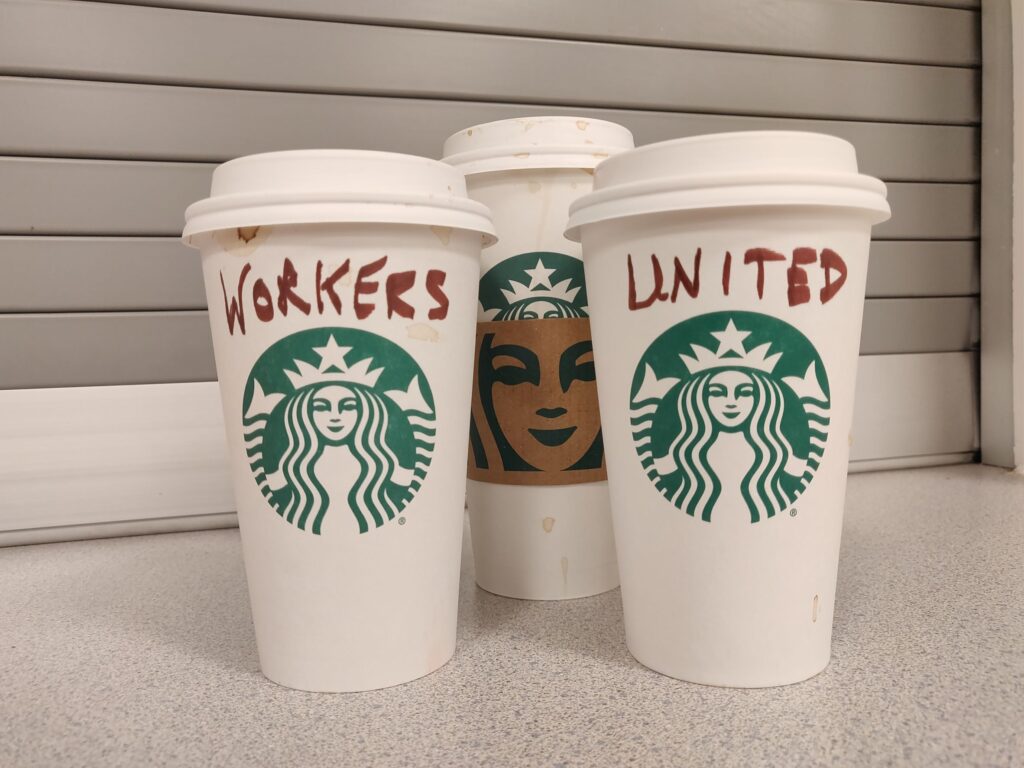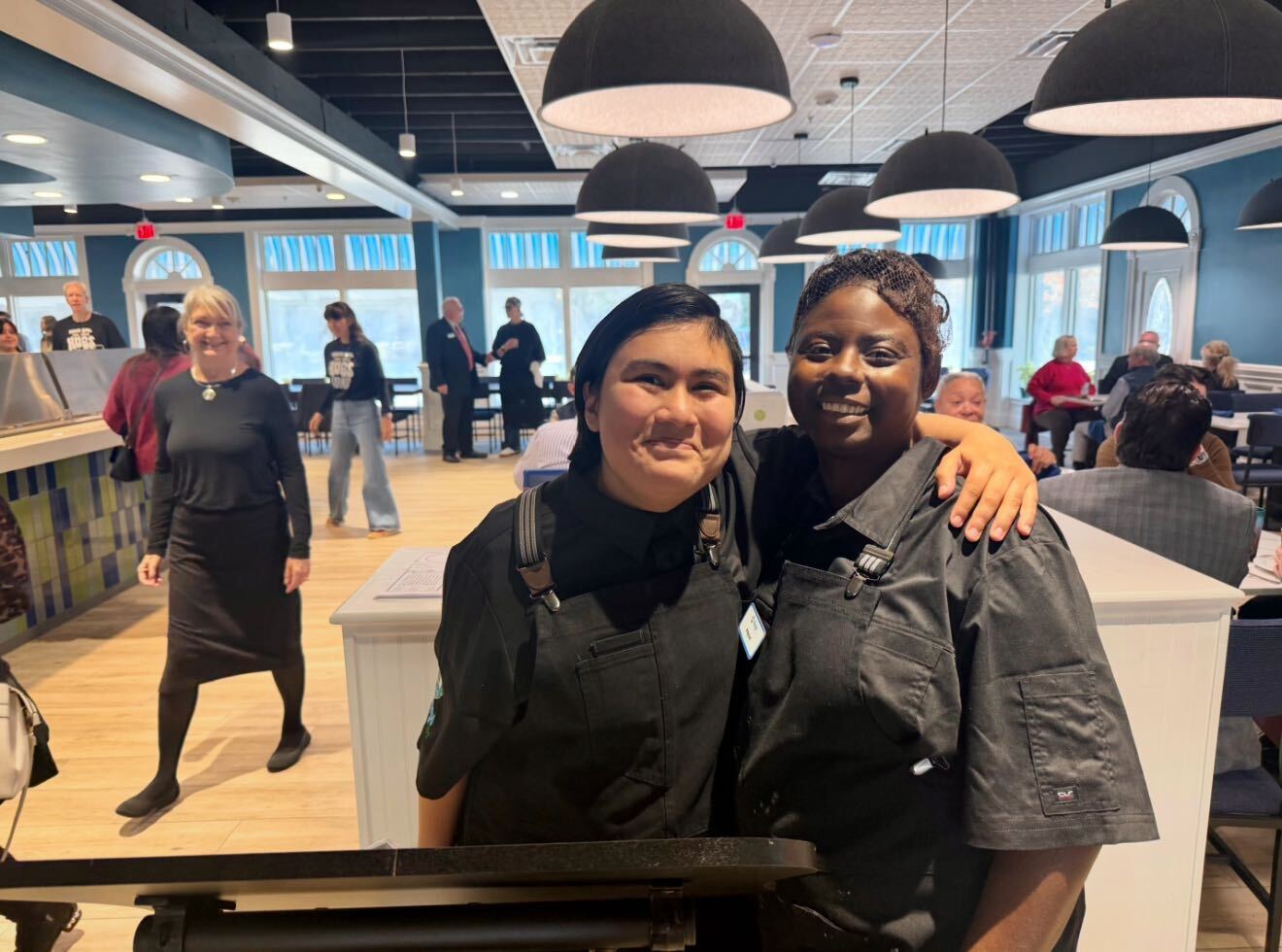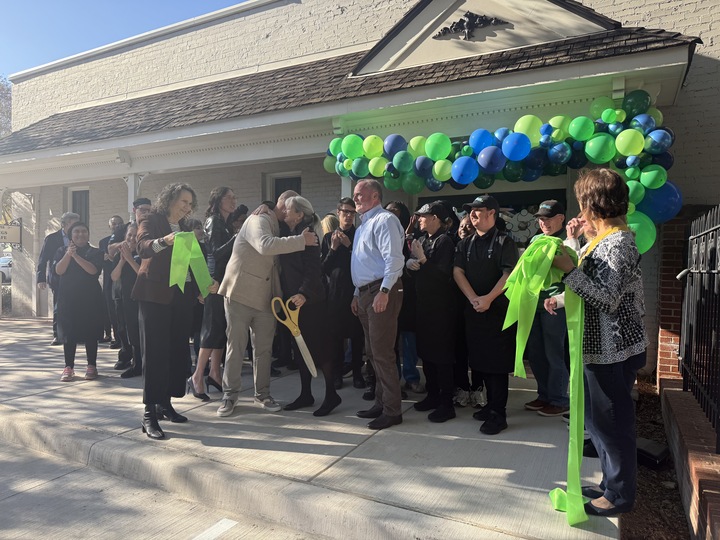(BATTLE GROUND, Wash.) — Billie Adeosun is afraid to go to work for fear of retaliation, but that doesn’t stop her. The barista at the Cooper Point Village Starbucks in Olympia, Washington is the lead labor organizer at her store, one of more than 225 Starbucks cafés that have filed for unionization with the National Labor Relations Board (NLRB) as of May 1.
Adeosun’s store vote was tallied on April 29. The vote was 19-2 in favor, making the café one of now 47 Starbucks locations to vote to unionize across the nation since December, according to More Perfect Union’s tracker.
The win did not come easy. The day after signaling an intent to unionize in late February, Adeosun was written up by her store manager. “They were saying that I was swapping shifts too often,” she said. The practice was “encouraged six months ago,” she noted. “Out of nowhere, they’re saying that swapping shifts is the same as calling out.”
Many Starbucks employees claim to have been highly scrutinized, written-up, or fired in retaliation since the unionization wave began in Buffalo, N.Y. Seven Starbucks baristas in Memphis were fired on Feb. 8 after being interviewed for local television about the union effort, according to The Washington Post.
On April 22, the NLRB filed suit against Starbucks, alleging that it wrongfully terminated three employees in retaliation for union organizing. VICE reports that 18 pro-union baristas including the “Memphis 7” have been fired, and many more written up since February, for dress code violations, clocking in early, and other issues that previously had not been cause for concern.
Adeosun asked her store and district managers for details on the policy that led to her being written up. “I still can’t get a specific time or a specific date as to when this policy went into action,” she said. Starbucks did not respond to a request for comment from The Click about this allegation.
Despite her fears of retaliation, Adeosun says it was worth it. “The majority of my store is extremely excited about unionizing,” she said. But she knows this is just the beginning. “Because this is such a new undertaking, we are really at the grassroots level,” said Adeosun. “We don’t know what negotiating a contract truly looks like yet.”
Why are workers unionizing?
When COVID-19 hit in March 2020, only 10.3% of U.S. jobs were union, reported the Wall Street Journal. This was the lowest rate since 1983, the first year for which comparable data are available, according to the Bureau of Labor Statistics.
With labor power at record lows, “essential workers” were suddenly being forced to work long hours, while being exposed to the virus at high rates, as reported by Vox. Frontline workers were soon being crushed by the weight of the pandemic due to a delayed federal response to COVID-19, a health care system woefully unprepared for the crisis, and other lethal mistakes like mixed messaging about the severity of the virus.
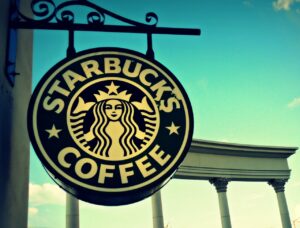
[Credit: Dennis Kendall]
“We have a CEO who’s bragging about the level of profits that have been raked in by this company, and none of that is being passed down to the workers,” Buffalo barista Michelle Eisen told Bloomberg.
Video: Bloomberg Quicktake interview with Michelle Eisen
With the pandemic, wealth inequality, and other factors driving discontent, workers across the country have begun focusing intently on workplace organizing, with those already in unions bargaining for better pay and working conditions, and non-union employees forming unions.
An article published on May 1 by Jacobin labor reporter Alex Press details how workers in the U.S. are still fighting for an eight-hour workday, 136 years after it was called for on the first May Day.
The pandemic exacerbated already existing problems for workers, especially in the service industry. Casey Moore, another Buffalo barista, told Forbes that “we want a seat at the table, to decide democratically” how to improve working conditions. “[T]hings like seniority pay, adequate staffing, credit card tips,” he said.
U.S. labor movement picks up steam
“Organized labor in the United States is not just in a downturn, but on the floor,” Press told The Click. “We still have an incredibly low unionization rate…it’s below 7% in the private sector,” she said.
While recent labor efforts have not yet brought union membership out of its record lows, Gallup polls show public approval of unions is at 68%, its highest point in over 50 years. And workplace unionization is gaining momentum.
“You are in the process, along with many others throughout this country, of standing up for justice, standing up for dignity, and helping to revitalize the trade union movement in this country, which will give workers a seat at the table!” -Sen. Bernie Sanders
According to ABC News, Starbucks Reserve Roastery, the company’s flagship store in Seattle, voted to unionize on April 21. To date, 47 locations have won unionization votes, with only five losses. There are more votes happening every week. Most have been landslides, and several were unanimous, reports VICE.
On April 24, Starbucks Workers United held Unity Fest in Richmond, Virginia, featuring live music and a speech from Vermont Sen. Bernie Sanders. The event took place days after five stores in Richmond won their union votes on April 19. “You are extraordinary American heroes and heroines,” Sanders told the cheering crowd.
Video: Sen. Sanders at Unity Fest on April 24
The labor struggle in the Pacific Northwest
Portland, Oregon has been a major hub of recent labor efforts, with workers at Nabisco, Fred Meyer and QFC striking late in 2021, the formation of unions by workers at Voodoo Doughnuts and Burgerville, and a near-strike by City of Portland workers in February, during which workers chanted, “Portland is a Union Town!”
Across the broader Pacific Northwest, labor organizing is ramping up. Nearly 1,000 shipyard workers in Seattle and Portland are negotiating a tentative agreement, and some 1,600 nurses are in the midst of a strike-authorization vote at Providence St. Vincent in Portland.
Meanwhile, Starbucks stores from Eugene, Oregon, to Seattle (where Starbucks began) are seeking unionization. At least 34 stores in the Pacific Northwest have filed for or held elections, according to unionelections.com.
The “letter of the law”
The recent wave of unionization efforts comes after the Biden administration implemented sweeping changes at the NLRB. Peter Robb, the general counsel appointed by President Trump, was a Reagan-era union buster, who had helped dismantle the Professional Air Traffic Controllers Organization (PATCO) in 1981. Robb was fired on the day Biden took office.
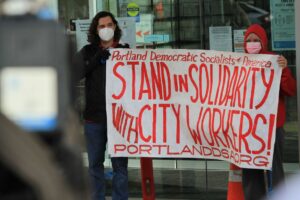
Portland Democratic Socialists of America (DSA) Stand in Solidarity with City of Portland workers in February. [Credit: Brian Mason]
Abruzzo also issued a memorandum stating that certain mandatory meetings may constitute unfair labor practices. So-called “captive-audience meetings,” in which employers speak to employees about the dangers of unions, are often used to dissuade employees from forming unions. Amazon and Starbucks are among employers that use captive-audience meetings.
Press points out that the NLRB is “just carrying out the letter of the law” for the first time in decades.
Starbucks’ anti-union campaign falters
Howard Schultz, now three-time CEO at Starbucks, told employees during a town hall on April 4 that companies are “being assaulted, in many ways, by the threat of unionization.” The same day, a pro-union Starbucks employee was fired at a store in Arizona, another in the pattern of firings reported by VICE.
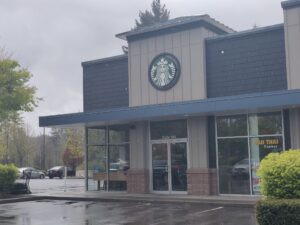
Cooper Point Village Starbucks in Olympia, Wash. voted to unionize on April 29. [Credit: Justin Mason]
Others have charged that Schultz worked to dissolve the first Starbucks union shortly after he acquired the company, and he has fought off unions at the coffee chain ever since. Now that workers are unionizing across the nation, Schultz is back at the helm.
Barista Amber Huston of the newly unionized Olympia café spoke with The Click (off the clock, of course) about a video that partners were made to watch. “They allocated time this whole week to watch an hour video…I’d rather have been on the floor helping my fellow baristas,” said Huston, who was thrilled with Friday’s unionization vote.
At today’s town hall in Seattle, Howard Schultz just said that “there is a group — an organization — trying to take our people.” Newsflash: Our union isn’t trying to take Starbucks’ people — our union *is* Starbucks’ people!
— SBWorkersUnited (@SBWorkersUnited) April 4, 2022
“Starbucks has done an incredible job at using scare tactics and making people afraid of retaliation,” Adeosun told The Click. “Every day now I go to work, and I’m terrified that I’m going to get fired for something I had no idea was a rule.”Starbucks replied by email to an inquiry from The Click regarding the company’s position on unions: “From the beginning, we’ve been clear in our belief that we are better together as partners, without a union [bolded in email] between us, and that conviction has not changed.”
Yet as more cafés across the country vote to unionize, the forward momentum of Starbucks Workers United shows no sign of cooling down. In fact, Starbucks’ multi-million dollar union-busting project may have backfired.
Press agrees that the anti-union campaign may have further emboldened workers to unionize. “I think the hope was that by bringing Howard Schultz back, they could stymie some of this,” she said. “When you see [Schultz’s] statements to workers, now that he’s speaking to more of them, it only fuels the organizing.”
Despite Schultz’s return as CEO, captive-audience meetings, alleged retaliatory firings, and Starbucks’ multimillion-dollar anti-union campaign, cafés like Adeosun’s continue to vote in favor of unionization.
“Starbucks likes to say that a union is a third party, which we found is completely untrue because we are the union,” she said.
